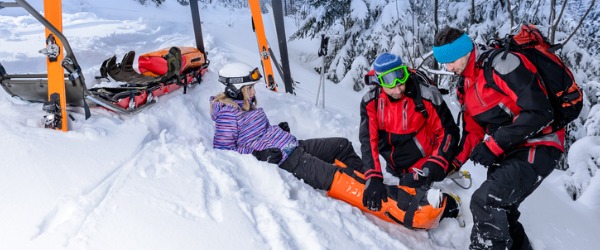What is a Ski Patroller?
A ski patroller ensures the safety and well-being of guests at ski resorts and mountainous areas. These individuals are trained in first aid, rescue techniques, and avalanche mitigation to respond to emergencies and provide assistance to skiers and snowboarders in need. Ski patrollers patrol designated ski trails and off-piste areas, monitoring for hazards such as icy patches, fallen trees, or obstacles, and taking action to mitigate risks and maintain a safe environment for guests.
In addition to emergency response and rescue duties, ski patrollers also play a proactive role in promoting safety and educating guests about mountain etiquette and terrain awareness. They often work closely with other resort staff, including ski instructors, lift operators, and guest services personnel, to ensure a positive and enjoyable experience for visitors while prioritizing their safety and well-being on the mountain.
What does a Ski Patroller do?

Duties and Responsibilities
Ski patrollers have a range of duties and responsibilities focused on ensuring the safety and well-being of guests at ski resorts and mountainous areas. Some of these duties include:
- Emergency Response: Ski patrollers are trained in first aid, CPR, and emergency medical procedures to respond quickly and effectively to accidents and injuries on the mountain. They assess the situation, provide medical assistance, and coordinate with other emergency responders as needed, such as ski patrol teams, ambulance services, or search and rescue teams.
- Rescue Operations: Ski patrollers are responsible for conducting rescue operations to assist skiers and snowboarders who may become lost, injured, or stranded on the mountain. This can involve using specialized equipment such as sleds, ropes, and rescue toboggans to transport injured guests safely down the mountain or to access remote or challenging terrain.
- Avalanche Mitigation: In areas prone to avalanches, ski patrollers play a critical role in mitigating risks and ensuring the safety of guests. They may use explosives or other techniques to trigger controlled avalanches, reducing the risk of uncontrolled avalanches and ensuring that ski trails and off-piste areas are safe for use.
- Trail Maintenance: Ski patrollers patrol designated ski trails and off-piste areas, monitoring for hazards such as icy patches, fallen trees, or obstacles. They take action to mitigate risks by marking hazards, closing unsafe areas, and conducting maintenance activities such as grooming trails and clearing debris.
- Guest Assistance: Ski patrollers provide assistance and information to guests, including directions, trail recommendations, and safety tips. They may also assist with equipment adjustments, lift loading and unloading, and other guest services to ensure a positive and enjoyable experience for visitors.
- Safety Education: Ski patrollers play a proactive role in promoting safety and educating guests about mountain etiquette and terrain awareness. They may conduct safety checks on ski lifts and equipment, provide information about trail conditions and weather forecasts, and deliver safety talks or demonstrations to guests.
Types of Ski Patrollers
Ski patrollers fulfill various roles and responsibilities within the ski industry, and their specific duties may vary depending on their training, experience, and the needs of the resort. Here are some types of ski patrollers commonly found at ski resorts:
- Alpine Ski Patrollers: Alpine ski patrollers are responsible for patrolling designated ski trails and providing assistance to guests at alpine (downhill) ski resorts. They respond to accidents and injuries on the mountain, conduct rescue operations, and perform trail maintenance and hazard mitigation activities.
- Nordic Ski Patrollers: Nordic ski patrollers focus on patrolling cross-country ski trails and backcountry areas where skiing is primarily done on flat or gently rolling terrain. They assist skiers who may become lost or injured on the trail, provide first aid and medical assistance, and ensure the safety of guests in remote areas.
- Snowboard Patrollers: Snowboard patrollers specialize in providing assistance to snowboarders at ski resorts, including responding to accidents and injuries on terrain parks, halfpipes, and other snowboarding features. They are trained in snowboard-specific rescue techniques and may also assist with terrain park maintenance and safety inspections.
- Avalanche Rescue Teams: Some ski resorts have specialized avalanche rescue teams composed of highly trained ski patrollers who are responsible for mitigating avalanche risks and responding to avalanche emergencies. These teams conduct avalanche control work, including using explosives to trigger controlled avalanches, and are equipped to perform rapid avalanche searches and rescues in the event of an avalanche burial.
- Backcountry Ski Patrollers: Backcountry ski patrollers operate in remote or wilderness areas outside of ski resort boundaries, where skiing is done in uncontrolled and often hazardous terrain. They are trained in wilderness first aid, avalanche safety, and navigation skills and may assist with search and rescue operations in partnership with local rescue organizations.
What is the workplace of a Ski Patroller like?
The workplace of a ski patroller is predominantly outdoors, situated within the mountainous terrain of ski resorts and backcountry areas. Ski patrollers spend the majority of their time on the slopes, traversing ski trails, and off-piste terrain to monitor for hazards, assist guests, and respond to emergencies. Their workplace environment varies with the weather conditions, ranging from sunny days with clear skies to snowy, windy, or even stormy weather conditions.
Ski patrollers typically operate from base lodges or patrol stations strategically located throughout the resort, serving as hubs for equipment storage, first aid supplies, and communication with other resort staff. These facilities may include offices, meeting rooms, and rest areas where patrollers can convene for briefings, training sessions, and coordination of patrols. Additionally, ski patrollers may utilize specialized vehicles such as snowmobiles, rescue sleds, or snowcats to access remote areas of the mountain quickly and efficiently.